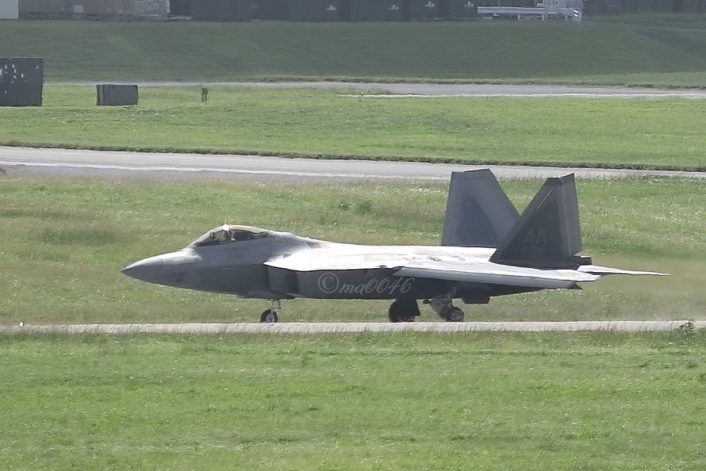Rare F-22 tire blowout incident caught on camera.
Images taken by X user @ma6400 outside Kadena Air Base in Okinawa, Japan, show a quite rare incident involving a U.S. Air Force F-22 Raptor aborting takeoff due to a tire blowout. Images of this nature are seldom captured or shared online, making them particularly notable in the context of aviation safety. Tire blowouts on high-performance military jets like the F-22 are dangerous and can also lead to serious consequences, both for the aircraft and its crew.
F-22離陸🛫
タイヤバーストした🥲 pic.twitter.com/NQrkaqyAlR— 0046 (@ma6400) October 18, 2024
In the photos and video captured by @ma6400, the F-22 appears to have aborted its takeoff after the left main landing gear tire burst, which is a serious event for any aircraft, particularly high-speed fighters: when an aircraft is moving at high speeds along the runway, a burst tire can compromise control and potentially lead to more severe incidents, including skidding, fire, or damage to the airframe.
音声は編集(音無し)
相方動画📱 pic.twitter.com/wJ2zY0tEoa— 0046 (@ma6400) October 19, 2024
In this case, you can see the F-22 slowing down on the runway and then continuing to taxi, with the airframe slightly tilted to the left due to the missing tire on the left landing gear.
Based on the tail code “AK”, the F-22 involved in the mishap is one of the Raptors from the 525th Expeditionary Fighter Squadron out of Joint Base Elmendorf-Richardson, Alaska, deployed to Kadena at the beginning of the month to beef up the U.S. air superiority capabilities in the Pacific region as the base phases out its few remaining F-15C Eagle jets.

By the way, although of a different nature, a previous incident occurred at Kadena Air Base on April 11, 2024, when a U.S. Air Force F-22 Raptor experienced a nose gear malfunction, leading to its collapse on runway 23L/5R.
Burst tire
A burst tire, also known as a tire blowout, occurs when a tire rapidly loses pressure due to a rupture or damage. This can happen for several reasons, including:
- High-Speed Operations: the rapid acceleration and deceleration of military aircraft (in particular, fast jets) generate significant forces on the tires, increasing the likelihood of a blowout.
- Heavy Loads and Stress: pressure on the tires, particularly when landing with high sink rates or taking off with a full payload can put strain on the tires and lead to structural weaknesses and blowouts.
- Extreme Temperatures: Aircraft tires are exposed to extreme heat due to friction with the runway during high-speed landings and take offs. Military aircraft tires, especially those on fighter jets, experience more intense heating because of the rapid deceleration from landing at higher speeds, which can cause the tires to overheat and potentially fail.
- Runway Conditions: runways might not always be in optimal condition, with debris or rough surfaces contributing to tire damage.
- Tire Wear: worn tires are more susceptible to blowouts, especially under the high-speed and high-pressure conditions of military aviation.
- Braking Systems: modern military aircraft like the F-22 Raptor use high-performance braking systems, which, when engaged, can generate tremendous heat. This heat can transfer to the tires, leading to thermal degradation and increasing the risk of blowouts, especially if the tires are already under stress from the high loads or landing impacts.
A blown tire during takeoff can put enormous stress on the aircraft’s landing gear and brakes, particularly if the pilot must decelerate rapidly after aborting. The weight and speed of the F-22 make such situations hazardous, requiring immediate and decisive action from the pilot. Tire blowouts can also damage other parts of the aircraft, such as the undercarriage, and potentially lead to the need for extensive repairs. In extreme cases, the aircraft could veer off the runway, leading to a more catastrophic event. Fortunately, in this incident, the F-22 appears to have come to a controlled stop, avoiding further damage.
Why These Photos Are Unique
It is relatively rare to find photographs of such events involving an F-22, as operational incidents like this are not often captured or released to the public. The F-22 Raptor is one of the most advanced fighters in the world, and the U.S. military maintains strict control over imagery involving this aircraft, particularly during operational mishaps. The fact that this event was documented at all makes these photos significant, giving aviation enthusiasts and experts a rare glimpse into a potentially hazardous situation.
Anyway, burst tire incidents happen relatively frequently also in civil aviation.
On Aug. 24, 2024, United Flight 759, a Boeing 737-900ER registered as N37427, experienced a tire issue while departing from Denver International Airport en route to Seattle. The flight, which carried 172 passengers and 6 crew members, landed safely in Seattle, where emergency services were on standby as a precaution. The plane was towed to the gate, and all passengers disembarked without incident.
On the same day, a similar event occurred with Qantas Airways. Flight QF6, operated by a Boeing 787 Dreamliner, sustained damage during takeoff from Rome’s Leonardo da Vinci–Fiumicino Airport. Reports from X indicated that the tire tread separated, causing minor damage to the aircraft’s lower right wing. The flight, bound for Perth, proceeded without further complications, and the damage was only discovered upon landing during a routine post-flight inspection. The aircraft was taken out of service for repairs, and affected passengers were rebooked on alternate flights within a few hours.
This type of incident is not isolated. In July 2024, an American Airlines flight departing Tampa for Phoenix also experienced a tire blowout just before takeoff, which led to a fire. Emergency responders quickly addressed the situation, and no injuries were reported.
In this case, the incident was caught on camera.
A big thank you to @ma6400 for allowing us to use his photos and video!

